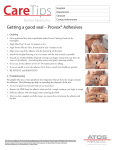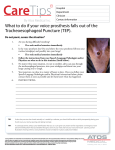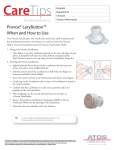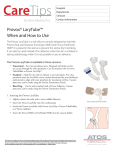Download How to Tell When You May Have a Problem with Your
Transcript
7 Hospital Department Clinician Contact information How to Tell When You May Have a Problem with Your Voice Prosthesis Signs of possible leakage with your voice prosthesis* • You cough when you eat or drink • Your mucus is the same color as the food or liquid you ate or drank Follow these steps before calling your speech pathologist: 1. Stand in front of a mirror with a good light; 2. Clean your voice prosthesis as described in the product manual using the Provox Brush and/or Provox Flush; 3. To see if your prosthesis is leaking follow these steps: a. Take a sip of colored liquid (i.e. milk, coffee, juice) so that it is easy to see; b. Look to see if any of the liquid leaks through or around the prosthesis; c. If nothing is leaking through take a larger sip of the liquid and check again; d. If you cannot see your prosthesis clearly, ask someone to look for you. 4. If the leaking has stopped it might have been a bit of food or liquid keeping the valve open temporarily. Clean your voice prosthesis again following the instructions in the product manual; *If any problems are noticed that are not listed here, the patient should still take action and contact their speech pathologist. Provox® is protected by patents, patents pending and design patents and design patents pending. Provox® is a registered trademark owned by Atos Medical AB, Sweden. This text does not replace nor does it set forth the complete contents of the User Manual and/or Prescriber Information for the products in this text, and is not a substitute for reviewing and understanding that important information. Therefore, before prescribing and/or using any of the products included in this text, please review the entire contents of the respective User Manual and/or Prescriber Information. For more information contact us at: [email protected] • www.atosmedical.us • 1.800.217.0025 © Atos Medical AB, 201203 MC0689-ThUS MC0689 5. If your prosthesis continues to leak and/or you cough while eating or drinking call your speech pathologist to have it checked. If the liquid is coming from the center of the prosthesis, then place a Provox Plug as described in the manual. 7 Hospital Department Clinician Contact information How to Tell When You May Have a Problem with Your Voice Prosthesis Additional signs to look for* • • • • It is difficult to speak It feels hard to talk The sound of your voice and speech has changed Your voice prosthesis and the area around it looks different Follow these steps before calling your speech pathologist: 1. Stand in front of a mirror with a good light; 2. Clean the voice prosthesis with the Provox Brush and/or Provox Flush as described in the manual; 3. 4. 5. Test your voice by saying “ah” and counting out loud from 1-15; If your voice is better, then it may have been that there was mucus/food/liquid blocking the prosthesis; and Call your speech pathologist as soon as possible if… a. b. c. d. You have trouble inserting the brush; You have blood on the brush; You have trouble flushing the prosthesis; and/or If any of the signs in the box above continue. *If any problems are noticed that are not listed here, the patient should still take action and contact their speech pathologist. This text does not replace nor does it set forth the complete contents of the User Manual and/or Prescriber Information for the products in this text, and is not a substitute for reviewing and understanding that important information. Therefore, before prescribing and/or using any of the products included in this text, please review the entire contents of the respective User Manual and/or Prescriber Information. For more information contact us at: [email protected] • www.atosmedical.us • 1.800.217.0025








